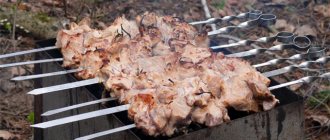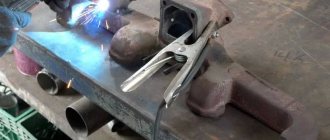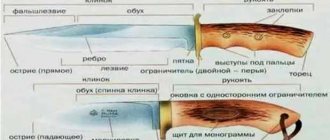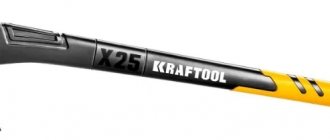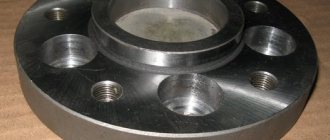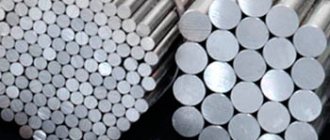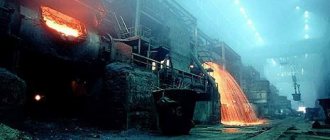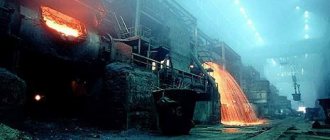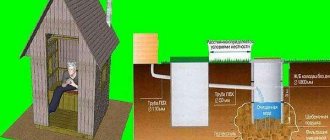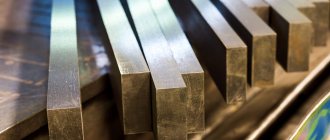When purchasing this or that product in a store (for example, dishes (a frying pan or a saucepan), or a water tap), many do not even realize that it is made of silumin alloy.
To make it more clear, silumin alloy has a composition of certain metals (based on aluminum and silicon), plus impurities (Fe, Mg, C, Cu).
Marking [edit | edit code ]
- A - aluminum
- K - silicon,
- ## is the percentage of silicon in the alloy,
- @@ - other chemical elements contained in the alloy (if any).
There is another marking: AL##
, Where:
- AL - cast aluminum,
- ## — alloy number.
The most common brands:
- AK12 - 12% silicon, eutectic alloy.
- AK9 - 9% silicon.
- AK7Ts9 - 7% silicon, 9% zinc.
Marking
Based on the variability of alloys, a special silumin marking was developed. Thanks to it, it is possible to quickly and accurately select a material with the desired properties, determine the composition, percentage of elements and physical properties.
Read also: Face mills for metal GOST
Marking is based on a combination of alphabetic and digital designations. The letters indicate the components that make up the alloy, for example, A-aluminum, K-silicon, C-zinc. The order of the letter designations is determined based on the percentage of components, so the silumin brand always begins with the letter A.
The numbers indicate the percentage of each component except aluminum in the composition. For example, AK20 indicates the presence of 20% silicon and, accordingly, 80% aluminum.
It should be noted that labeling may vary depending on manufacturers and country of production. Therefore, when purchasing products with unclear markings, it is better to consult with the seller.
If you find an error, please select a piece of text and press Ctrl+Enter.
Modern metallurgy supplies over 1000 items of various types of materials. But the silumin alloy still occupies a prominent place among them. Its application continues to cover more and more new industries for the past 15 years. What properties do not allow it to lose its relevance to this day? What is it?
General information
Alloys based on aluminum and silicon are called silumins. They belong to the category of casting alloys and occupy about 55% of the entire aluminum metallurgical industry.
There are 2 main varieties:
- simple, containing only 2 components in composition: silicon (up to 15%) and aluminum.
- special, including additional alloying elements.
Two-component silumin is not thermally strengthenable and has low mechanical characteristics. The only possible way to increase strength is to reduce the rate of solidification of the casting in the mold or add alkali metal alloys such as strontium, lithium or sodium to the melt.
Increasing the crystallization rate gives more preferable results, but has one important drawback. In the case of casting thin-walled parts, the likelihood of cracks forming on the surface of the castings increases. The only way to avoid this is to use injection molding technology, which is more costly from an economic point of view.
Modification with alkali metals gives a lesser strength effect, but this process is more technologically advanced and universal. For this reason, it is more common in practice.
The improvement in mechanical properties here occurs due to changes in grain size. The internal structure remains unchanged.
The greater the amount of silicon in silumin, the greater the effect of modification. It is the silicon grains that undergo recrystallization in silumin alloys, and it is due to this that the mechanical properties are improved. Therefore, when the silicon content is less than 5%, modification becomes meaningless.
Special silumin alloys, in addition to silicon and aluminum, contain components such as magnesium, copper and iron. The introduction of these elements makes the material thermally hardenable. For this reason, special alloys have higher mechanical properties compared to simple alloys. This is especially true for such a parameter as the yield strength.
Heat treatment in most cases consists of hardening and subsequent artificial aging. Thus, AL4 hardening takes place at 550 ºС and is maintained at this temperature for 3-5 hours. After this, the alloy is sharply cooled in water and sent to the furnace. Artificial aging (175 ºС) is already carried out there, which finally refines the material in terms of physical structure and mechanical characteristics.
Also, all silumin alloys belong to the first group of weldability. Welding does not require additional preparation in the form of preheating the part. The welded seams are dense and are not inferior in strength to solid alloys.
Application [ edit | edit code ]
They are used for casting parts in the auto, motorcycle and aircraft industries (for example, crankcases, cylinder blocks, pistons), and for the production of household appliances (heat exchangers, sanitary shut-off valves, meat grinders), in sculpture technology, in cheap electro-pneumatic replicas of weapons , sometimes they make keys.
The disadvantage of silumin is the high porosity and rough coarse-grained eutectic of castings, which greatly affects the reproducibility (stability) of the strength properties of the resulting parts. [1]
Products made of silumin are increasingly found on store shelves. These can be frying pans, pots, water taps and other products. This material is obtained artificially; you will find a more detailed answer to the question: silumin - what is it, in the article below.
Area of application of silumin
Today, the scope of application of silumin is varied, but it is most often used in the production of cars and aircraft. Main areas of application:
- It has gained high popularity in the aircraft industry due to its combination of low weight and high strength, which is very important for lifting aircraft into the sky and saving fuel.
- Similar properties are desirable in automobile production. Thus, the weight of the car directly affects the driving characteristics of the car, maneuverability on the road and fuel consumption. In the field of mechanical engineering, the alloy is used to produce engine parts.
- Recently, silumin has gained particular popularity in the weapons industry, especially for the production of air rifles. Airsoft players prefer weapons made from this material due to its light weight, high strength and reliability, which, given the high cost of such rifles, is an irreplaceable quality.
- It is also used in the production of many household products, from pots and pans to faucets. Household products made from silumin are popular due to their low cost.
Description of material
The definition of silumin is easy to find on Wikipedia - it is an aluminum-based alloy with the addition of silicon. In this case, the content of the additional component ranges from 4 to 22%, and the main part is aluminum. The composition of the silumin alloy also contains a small amount of impurities of other metals: copper, calcium, titanium, iron, zinc, manganese and others.
Since the maximum amount of silicon is up to 22%, it is externally easy to distinguish it from real metal. It is slightly darkened, so it resembles cast iron, but only an experienced person will be able to actually recognize this material.
What is silumin in real life, and where is it found?
Pricing
Aluminum is one of the five most common metals on planet Earth. Despite this, its production is gradually declining. This happens due to the deepening of aluminum ore deposits on the one hand, and on the other hand the developed market for secondary metals. For this reason, it is more profitable from an economic point of view to recycle aluminum alloy.
The cost of silumin depends on the following factors:
- Chemical composition. The more aluminum, copper and titanium, the higher its price on the scrap metal market.
- Knowledge of quotes on non-ferrous alloys exchanges. In terms of cost, silumin alloys are correlated according to the prices of their constituent metals, the cost of which is determined on world exchanges.
- Scrap quality. The presence of traces of corrosion on the surface greatly reduces the cost.
- Batch size. Scrap metal collection points give preference to dealing with large deliveries, as this reduces turnover time. Therefore, if scrap is delivered in excess of one ton, they mark it up.
Rate this article:
Currently, new methods for modifying the state of the surface layer of various materials are being actively developed and studied in order to give them the required properties [1], since the capabilities of traditional methods of chemical-thermal treatment are practically exhausted. Fundamentally new opportunities for modifying the surface properties of various materials and significantly improving their performance characteristics have been provided by the use of concentrated energy flows (CEF) in industry [2]. Particularly relevant is the use of such methods for the modification of aluminum alloys, the wider use of which in industry is hampered by low tribological and strength characteristics.
Despite significant progress in materials science, in particular in the field of creating new alloys and composites that are superior in properties to aluminum-based alloys, the latter will continue to occupy leading positions in many industries for a long time. This is primarily due to the relatively low cost of these alloys and the possibility of widespread use of secondary raw materials in their production. Considering the high volumes of consumption of aluminum alloys, the struggle for even a relatively small improvement in their quality may be justified.
One of the most important aluminum alloys is silumin or an alloy of aluminum and silicon. The state diagram of silumins has a simple eutectic form, as can be seen from Figure 1, which is why industrial silumins are divided according to silicon content into hypoeutectic (4-12% Si), eutectic (12.2% Si) and hypereutectic (over 12% Si). Silumins are widely used in aviation, shipbuilding, automotive and for household needs due to their mechanical properties. Aluminum alloys occupy second place in terms of the breadth of application after steel and cast iron.
The industrial importance of silumins is due to their high fluidity, low tendency to shrinkage during casting, and the possibility of soldering and welding. However, hypereutectic silumins have found only limited use due to the presence in the structure of a very hard silicon component, which significantly reduces the durability of the cutting tool [3], which is to some extent compensated by the increased elastic modulus compared to hypoeutectic alloys, low temperature coefficient of linear expansion, and good weldability and machinability in terms of surface quality and low cost. In addition, the specifics of production and the special requirements for alloys of this system, necessary for precise control of the microstructure and porosity of castings, which exist for hypoeutectic industrial silumins, are not yet clear enough. Currently, hypereutectic silumins are most often used for the production of internal combustion engine pistons and a number of other parts manufactured by shaped casting or liquid stamping. But despite the limited use of hypereutectic silumins, interest in these alloys is growing.
Rice. 1. Al-Si phase diagram[4]
Rice. 2. Application of silumins: car parts made from hypoeutectic silumins (a, b, c, d) and cast pistons from hypereutectic silumins from the German company Mahle (e, f)[4]
In aviation, for example, the low specific gravity of aluminum-based alloys plays an important role. An aircraft's fuel consumption is largely determined by the weight of the aircraft, which plays a decisive role in the case of private aircraft, whose mass-to-cargo ratio is greater than, for example, cargo airliners. It is also worth noting that in the manufacture of various aircraft components and parts, aluminum-based wrought alloys are predominantly used. The volume of use of cast alloys due to their lower manufacturability is lower. At the same time, aircraft use welded-cast structures and components, for example, in gallery-cooled pistons, pumps, etc.
Read also: As10d31 DIY repair
In shipbuilding, silumins have become widespread due to their corrosive properties coupled with low specific gravity. It is well known that sea water is very rich in various salts and other substances that have a detrimental effect on the hull of a ship. It is also well known that aluminum and its alloys are used for aluminizing (aluminizing) - saturating the surface of steel or cast iron products with aluminum in order to protect the base material from oxidation under strong heating, i.e. increasing heat resistance (up to 1100 °C) and resistance to atmospheric corrosion.
Recently, there has been a prospect of using silumins in the space industry, where a special place is occupied by alloys for instrument technology, which require low values of the temperature coefficient of linear expansion in combination with the required level of mechanical properties. For the manufacture of various components of spacecraft, alloys with low specific gravity and low temperature coefficient of linear expansion are needed. Currently available precision alloys based on the iron-nickel system have unique physical properties. However, these alloys have a number of disadvantages, which mainly come down to complex technology for their production and processing, high cost and high specific gravity. In this regard, the world has recently paid much attention to the search for aluminum-based alloy compositions, among which the Al-Si system is the most promising.
In non-ferrous metallurgy, silumins are divided primarily into wrought alloys (hypoeutectic and eutectic) and casting alloys (hypereutectic). Cast aluminum alloys have a number of features: increased fluidity, which ensures the production of thin-walled and complex configuration castings; relatively low linear shrinkage; reduced tendency to form hot cracks. When casting, hypoeutectic silumins are used that are doped only with silicon or also have small amounts of other impurities (Cu, Mn). Their structure is a b-solid solution and eutectic (b + Si). The eutectic contains 12.5% Si. The maximum silicon content in the solid solution at the eutectic temperature (577°C) is 1.65%. By quenching such a saturated solid solution, it is possible to keep it in a supersaturated state for a short period of time (silicon solubility at room temperature is about 0.1%).
During aging, fine particles of the alloying component are released, but the strengthening effect is insignificant. By very rapid quenching, it is possible to briefly retain about 16% Si in the solid solution and shift the eutectic point to 17% Si. An effective silumin modifier is sodium in an amount of 0.01%. Modified silumin is not recommended for use in combination with Al - Mg alloys. It is also possible to modify silumin with phosphorus. Silumins, which do not contain other impurities besides silicon, are not thermally hardenable. Small amounts of magnesium due to the formation of its silicide make it possible to thermally strengthen the alloy. Unlike technical aluminum, small amounts of iron impurities have a negative effect on silumins, which is partially neutralized by manganese.
Iron with silicon gives brittle lamellar formations - b-phase (Fe2SiAl8) and c-phase (FeSiAl5). With a high silicon content, the formation of the d-phase (FeSi2Al4) and the g-phase (FeSiAl3) is possible. With a high iron content, the most refractory compound FeAl3 (Tm = 655°C) may appear. Manganese with iron gives mixed less brittle crystals (Fe,Mn)3Si2Al5. Alloying with copper along with magnesium makes it possible to obtain more complex strengthening phases (for example, Cu2Mg8Si6Al5) and, accordingly, achieve a greater effect as a result of thermal hardening [3]. Of all casting alloys, silumins have the highest fluidity. Following them are aluminum-magnesium and aluminum-copper alloys. We should also not forget about the oxidation of aluminum and its alloys with various acids using electrolytic methods and chemical methods for the purpose of additional protection against corrosion.
The work [2] reports a twofold increase in the microhardness of hypereutectic silumin (30 at.% Si) after treatment with strong pulsed ion beams. In this work, silicon crystallites in the eutectic become more dispersed, and the boundaries of primary silicon crystals are blurred and coarsened when p + ions act on the surface of hypereutectic silumin. Also in this work, the shift of the Al(111) peak was calculated and then the change in the lattice constant of aluminum was calculated depending on the silicon content in it.
The work [5] indicates a slight improvement in corrosion characteristics after treatment of hypoeutectic and eutectic silumins with laser radiation.
Basic properties of silumin
When compared, the properties of silumin are equated to the properties of stainless steel, but the former has less mass.
About the properties of aluminum alloy with silicon:
- Durability, resistance to wear and corrosion. The oxide film formed on the surface serves as protection against negative environmental factors.
- The density of the material is about 3 g/cm 3 .
- The plasticity or fluidity of an alloy is an important property necessary for casting complex configurations, which significantly reduces the cost of the casting process.
- The melting point of silumin is about 600 0 C, which is almost three times lower than the melting point of steel, and this also affects the quality of casting and the cost of work.
Based on the above indicators, products made from this material are increasingly in consumer demand.
Read also: What is meant by the hardness of a material?
Chemical properties
Despite the fact that this group includes alloys of aluminum and silicon, it should be noted that silumin can contain many other elements in small quantities. The composition of the alloy directly affects the characteristics of the finished products. The main condition for classifying an alloy as silumin is the percentage of silicon. It should be between 10% and 15%.
Due to the fact that aluminum makes up about 90%, the structure of silumin is very similar to the structure of aluminum. It is almost impossible to distinguish them with the naked eye.
The properties of silumin differ depending on the type of aluminum alloy. There are two types of metals in this group:
- normal silumins;
- wear-resistant.
The normal group has a silicon content of around 12%. The strength of alloys of this group is not at a high level, but they have other advantages. First of all, ease of processing and excellent casting properties. The absence of various impurities makes this type of silumin neutral to the effects of aggressive environments and various chemicals.
Wear-resistant alloys contain about 20% silicon. This composition gives silumin increased strength, significantly exceeding the strength of aluminum. But processing products made from this alloy is more complex and requires greater effort.
Characterizing the chemical properties of silumin, it should be noted that they practically do not differ from the properties of aluminum. They vary only slightly depending on the percentage of various additives. First of all, adding silicon to aluminum directly affects the physical properties.
How is silumin marked?
Marking of alloys is carried out based on the requirements of international standards of the ISO system:
- “AL 9” means: A - aluminum, L - foundry, 9 - percentage of additional constituent substance.
- “AK 15” is marked according to the same principle, only the letter “K” means “Silicon”.
Includes:
- 90% main component (aluminum);
- about 9% silicon;
- manganese up to 0.5%;
- titanium up to 0.1%;
- copper up to 0.6%;
- zinc up to 0.3%.
Marking is done as follows: for example, silumin alloy is AK5 Ts8. A is aluminum, K is silicon in an amount of 5%, C is zinc in an amount of 8%.
Types of silumin
The material is classified into 3 types:
- Preecteutic. It is characterized by the fact that the silicon content ranges from 4 to 10% of the bulk. This composition may also include additional elements: manganese, copper or magnesium.
- Type 2 - refers to more wear-resistant, with a silicon content of about 20%.
- Special alloys with the addition of impurities of other metals, for example, zinc or titanium.
Depending on the technical parameters, various castings are performed in production processes.
Alloy groups
Silumin alloys are divided into several groups. This distinction is made according to the purpose of the materials:
- AK 12 is a eutectic silumin containing 12% silicon. During heat treatment, the casting is not strengthened and does not become hard during shrinkage. Parts made of such material are structurally designed for sealed low-load devices.
- Highly alloyed hypereutectic silumin is labeled, for example, AK4M5. Belongs to the piston group and is used when performing work under high-temperature conditions. It has high resistance to high temperatures and wear resistance. The use of this alloy for particularly important products operating under high load conditions. These are large-sized and critical parts.
How to repair silumin products
Products made from this material may develop cracks or chips during use. How to glue silumin? To restore the appearance, you can use epoxy glue. But it is worth considering that this product will not work under increased loads.
Operation technology:
- Degrease the areas to be glued and dry a little.
- Dilute the glue in the appropriate consistency and apply it to the surface intended for gluing.
- Connect the parts of the product and apply force, then leave it at rest for a day.
Silumin repair using welding
It is a mistake to think that
welding silumin is a simple process that can be performed by everyone.
When welding products, many questions may arise. The material heats up quickly, as a result of which an oxide film begins to appear. This phenomenon will not allow the parts of the product to connect. Therefore, the choice was made in favor of welding with argon, since it is this gas that provides protection from external negative factors during operations. The alloy will better restore and strengthen the structure. How to weld silumin?
Process description:
- Prepare electrodes for welding; non-consumable tungsten ones are suitable for these purposes. For welding products, it is recommended to use solders: HTS-2000, Harris-52 or ER 4043, intended for welding aluminum structures.
- Degrease the welded edges.
- To ensure reliable weldability, the part must be fixed in a rigid fixture.
- Before carrying out welding work, the surface should be heated to 220 0 C. To remove the heat, steel gaskets should be used.
- Carrying out welding work. Alternating current is used for welding surfaces. The work is done manually.
This is interesting! Which inverter cooker is better to buy? The forums will tell you and suggest which tool is best to purchase for independent work.
After the work has been completed, the products can be operated at reduced loads. Before actually
welding silumin at home, it is recommended to practice on samples.
Where is silumin used?
The popularity of using silumin today is highest in the field of mechanical engineering and aircraft manufacturing. And this is not surprising, since the material is light and durable. It makes it easier for airplanes to lift, but for cars it affects the cost: the more weight, the lower the price.
Read also: Slotting device for lathe
It is used to produce spare parts such as pistons, engines, body parts and cylinders. Slav is often used in the production of weapons, for example, air rifles, including barrel boxes and almost all components of these weapons. In modern design, silumin weapons are light and comfortable to handle. The main disadvantage of structural elements is the fragility of the material, that is, with any minor impact, the product can crack or break. Silumin pans are lightweight, but again, fragile.
Silumin, the use
of which has become popular for gas turbine generators consisting of plate heat exchangers, is an excellent solution for equipping power supply systems. The melting point allows the material to be used for these products.
[edit] Guilt
There are industries where silumin suddenly turns out to be useful. For example, in the stretching of banners or other installation of temporary fortifications, which come down to galvanized frames made of the same metal-plastic or other shitty steels. It is easy and quick to sew the structure together with silumin rivets, and since they are actually disposable, after the expiration of the term it is easy and not a pity to break the house of cards. Often used in advertising, election campaigns, country scenes, etc.
In addition, as already noted, not every subtype of silumin is designed to crumble. The main advantage of suitable types is their high casting properties, which make it possible to produce parts of complex shapes. Such as heating radiators or gas reducers, which are very reliable, because they are installed on critical components and are unlikely to break out of the blue. In Sovka, street lamps were riveted from silumin, which turned out to be the most durable (they worked for 30-40 years). The Soviet door lock, which consisted of a little less than entirely silumin, worked perfectly for more than 20 years, but failed when the steel spring in it burst.
Thus, we get a typical price-quality fork, where it is advisable to produce something of a sufficiently complex shape and at the same time valuable enough for casting from Tru-Silumin to be profitable. In other cases, conscientious technologists look for alternatives - stamping, the above-mentioned substitutes, etc., but not very much - they reduce the cost of the alloy, ultimately arriving at the indicated state of the final product.
Silumin production
The production of silumin is carried out not only by large enterprises in the metallurgical industry, but also by private laboratories. Process improvements are constantly being upgraded.
- Metals for the charge are extracted from the ore; silumin can be produced from the ash that remains after the operation of thermal power plants. Ash is restored by electronization and with the help of the element cryolite. There are many other impurities in the charge that do not affect the quality characteristics of the alloy. The only thing is that iron affects the quality of the alloy, but if it is in the range from 0.8 to 1.5%, then this amount is allowed and is contained in waste from thermal power plants, so the use of such slags for the manufacture of products has a beneficial effect on the environment.
- In nature, compounds of aluminum and silicon are also found in bauxite ore, but, according to technology, alloys of these components are produced artificially, which helps improve the quality of finished products.
What is brass
The material looks like gold, but it is a compound of copper and zinc. To improve performance properties, nickel, iron, tin, lead and other ingredients are added to the composition. Impurities are about 10%, and zinc from 30 to 35%.
- density 8500 kg/m3;
- melting temperature from 880 to 950 0 C;
- easy to process;
- wear resistance;
- viscosity;
- Depending on the content of the predominant metal, it can be thermally conductive or electrically conductive.
Manufactured products: wire, foil, rods, metal sheets, pipes, fittings. It is used to make jewelry, photo frames and badges. The cost of the products is relatively low, and their service life is long, without losing their presentation.
Comparison of silumin and brass
Silumin or brass, which is better? Compared to brass, silumin is a more fragile material, but in terms of price characteristics it is cheaper.
Faucets and valves made of silumin have a short service life, they quickly rust and can quickly break if a technical accident occurs, which does not exclude flooding of the lower floors.
Energy metering devices using elements made from this material may also not withstand high pressure parameters and will quickly become unusable
The silumin material does not withstand high water temperatures, the service life of water taps does not exceed a year, microcracks gradually form on them, which leads to failure of the device.
For water supply systems, it is best to choose brass products, although they are more expensive, they can withstand hot water and high pressure.
How to distinguish silumin from brass? To distinguish these two materials, you should pay attention to the color of the product from which they are made: brass is yellowish, and silumin is white. Moreover, the first one is heavier than the second one.
Structural products made of silumin can be chosen for other purposes, in cases where the main load falls on other elements.
Products made of silumin are in demand today, as they are inexpensive and their appearance is quite aesthetic, but when choosing, it is recommended to have knowledge about their purpose.
Silumin is an aluminum alloy with a high silicon content. It is used to make parts of complex configurations. Cold and hot methods are used to restore them.
Silumin welding is carried out in several ways: with consumable and refractory electrodes. The metal oxidizes easily, so it is advisable to use a protective atmosphere. The quality of the connection suffers without it. This is due to heat-resistant aluminum oxides. Experienced welders will tell you how to weld metal and what subtleties are important to take into account.
Production
In the process of development of metallurgy, new methods of producing alloys appear. Old technologies are also being improved. Silumin can be produced in two ways:
- The first is to extract metal for the charge from ore. However, such a mixture will be saturated with foreign inclusions.
- During the operation of thermal power plants, ash remains, from which silumin can be made. It is mixed with cryolite and an alloy is obtained through the process of electronization.
You can also find a mixture of aluminum and silicon in nature. These two components are found in bauxite ore. However, it is possible to obtain an alloy that will be used in industry only artificially.
Features of silumin alloy
It is stronger than duralumin, resistant to corrosion, ductile - easily stamped, castable and forged.
Read also: How to test battery capacity
It is valued for its decorativeness, wear resistance, and lightness (it has a low specific gravity). Silumin is used in many industries; parts for cars and motorcycles, overhead elements for plumbing, and interior decoration are made from it.
Due to oxidative activity, the aluminum-silicon alloy is difficult to weld. In general, alloys with a high zinc content are not welded; when heated, it burns out and the metal becomes brittle. Foundry silumin with a silicon content of 5 to 22% is hot joined. During heat treatment, inert gases are used, mainly argon; it is heavier than air, settles on the workpiece, and is held in a cloud.
Brands and their properties
Silumins stand out due to their low specific gravity compared to other alloys and metals. The density of simple silumins does not exceed 2660 kgm3.
They are also distinguished by increased corrosion-resistant properties. The introduction of an additional percentage of magnesium and manganese only helps to increase this characteristic.
The addition of copper to the composition reduces its resistance to corrosion. Thus, AL5 alloy, containing 1.5% copper, is the most corrosion-unresistant grade compared to all other silumins.
As mentioned above, two-component silumins are significantly inferior in strength to alloyed silumins. Alloy AL2 after modification has a tensile strength of about 180 MPa. The yield strength is even lower and is equal to 80 MPa. Among the advantages of this category, it is worth noting high plasticity. Its relative specific stretch is 7%.
Another important advantage of AL2 is its low crystallization interval. For this reason, castings are less susceptible to the formation of shrinkage porosity.
AL4 is a more durable silumin and belongs to the group of thermally hardenable alloys. Silumin is characterized by a low silicon content (up to 7% of the composition) and improved casting properties. Its tendency to shrinkage and porosity is significantly lower compared to AL2, which allows it to be used as a material for the most critical castings. The tensile strength of AL4 silumin is 260 MPa, and the yield strength is 200 MPa.
Silumin AL9 is not strengthened either by modification or artificial aging. It's just being hardened. The alloy is widely used in production due to the optimal ratio of ductility, casting characteristics and strength. AL9 are destroyed under loads above 200 MPa. The relative specific stretch is 6%.
AL5 does not belong to the group of heat-resistant alloys, but is superior to all silumins in its resistance to thermal stress. The tensile strength of this brand is 220 MPa. Its plasticity is one of the lowest. The relative specific stretch is 1%. Also, as noted above, the presence of copper makes AL5 less resistant to corrosion.
AL34, in comparison with all the brands described above, has the best mechanical characteristics. The tensile strength is 330 MPa, which is comparable to St.3 steel. This strength is ensured by the content of additional amounts of beryllium, magnesium and titanium. Castings made from these alloys are distinguished by their increased tightness.
Read also: Turning products on std 120
It is also worth noting that the mechanical properties of castings are greatly influenced by the casting method. All strength values listed above are for sand casting. When casting in a chill mold or under pressure, the tensile strength and fluidity are usually 20-30 units higher. The reason for this is a higher rate of crystallization, which leads to the crushing of internal structures.
Soldering silumin
Decorative parts and those that do not experience stress can be soldered with a gas torch, the metal is heated to 200°C. Soldering silumin with thin walls is done with a soldering iron with a powerful tip. Metal linings are used to protect against oxidation. Only the work area is left uncovered.
- ER4043 – additive for cast aluminum alloyed with silicon and magnesium grades AD31, AD33, AD35;
- Harris52 – solder for aluminum with flux additives;
- HTS2000 is a Chinese analogue of Harris52.
The metal at the soldering site is heated to 600°C, the technology is the same as when working with aluminum. Castolin 190 Flux and its analogues are used to destroy the oxide film.
Silumin welding technology
The connection can be made in two ways:
- with the help of consumable electrodes, such welding is used to seal parts that work under compression;
- using filler wire.
Before welding silumin, you must:
- clean the joint to a mirror shine;
- remove the oxide film with solvent or gasoline; you must work with gloves so as not to leave traces of sweat and grease.
Argon arc welding of silumin
To work you need to prepare:
- welding inverter for 220V or 380V (current strength depends on the thickness of the area being repaired);
- an oscillator that supplies voltage to the electrode, it is needed to create an arc;
- set of gas equipment;
- burner;
- shielding gas cylinder;
- filler rod.
Silumin welding with argon has a number of features:
- The polarity should be reversed, a positive contact is connected to the electrode. This is necessary to ionize argon and increase its electrical conductivity.
- Argon should enter the work area only after ignition. The seam must be cooled in a protective atmosphere for at least 10 seconds until the top layer of metal sets.
- The additive is introduced in front of the burner, at medium speed, at an angle to the electrode and disk. A fast feed will produce a lot of sparks.
- The electrode is needed to create an arc; it should not be brought closer than 2.5 mm to the metal.
- The smooth movement of the torch and the rod must coincide.
- The filler wire diameter is always smaller than the electrode size.
Under the influence of the arc, the filler and edges form a homogeneous alloy. It is important to maintain a protective atmosphere and ensure that argon does not blow away. Without it, the oxidation process begins immediately.
Consumable electrode welding
Having a transformer or rectifier, you can weld the part using a consumable electrode OK 96.50 - a rod made of silumin, coated with an alkaline coating. Before use, it is heated to 150°C. The area of the part to be restored must also be heated with a blowtorch or gas torch to 300°C (dark spots of tarnish will appear on the metal; if they are yellow-brown, the temperature is 250°C). Surfacing is done at the same temperature. When welding silumin in this way at home, a strong seam will not be obtained; slag particles, and a lot of it is formed when working with a consumable electrode, inevitably remain in the melt.
Advantages and disadvantages of silumin argon arc welding
- unlike other methods of restoring parts made of silumin, using an arc in an argon atmosphere produces more durable connections;
- seam formation mode is high-speed, welding does not take much time;
- no need to preheat parts and electrode;
- proven technology suitable for beginners;
- the directed arc does not overheat the part, it does not deform.
- work cannot be carried out in open space; in enclosed spaces, drafts must be avoided so that the argon cloud remains above the work area;
- it is difficult to immediately select the welding mode;
- when working with thick-walled metal, you need to consider a method of heat removal;
- you need to have special equipment.
For those who regularly carry out repair work, the disadvantages of argon welding do not prevent them from creating high-quality and reliable connections.

